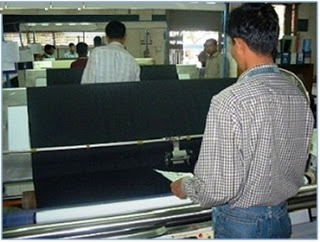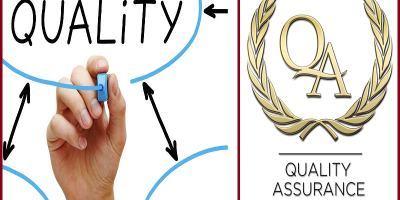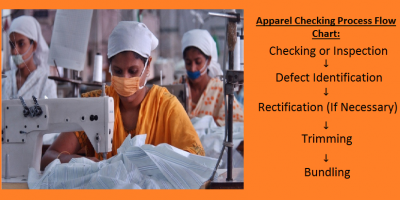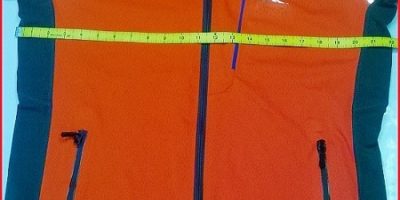The quality of a finished item in the apparel industry mostly depends on the quality of fabric when it is collected as a roll from mills. Even it occupies 60 – 70 percent of total garments cost. Apparel industry should take some defensive actions to ensure the quality fabric is only being used in their items and set up fabric inspection department with modern equipment and skilled manpower.
AIM: Fabric Mills and garments industry, both parties quality team should give their highest effort to erase any unexpected circumstances. Even the most outstanding/excellence manufacturing methods cannot compensate for defective materials.
* Garments producer: Have to inspect minimum 10% per color or more of any consignment when they got and assess them based on a four-point system. By this process, they can minimize fabric related quality troubles before it moved to production.
* Fabric Mill: Have to inspect 100% of finished goods; defects must be recorded on each roll.
Usually, four methods may be followed for fabric inspection process.
1) Graniteville “78” system.
2) Dallas system.
3) 4 point system
4) 10 point system
But, above all 4 point system is most popular and broadly used as it is very simple to applicable, educate and learn. Let’s find a tiny description of 4 point inspection system below.
To use this system someone has to know the following procedure:
1) Vast idea on nature of fabric defects (how an error looks and its appearance)
2) Fabric inspection method or preparation
3) Criteria for giving penalty points based on defects and defect length.
4) Calculation method of total penalty points for total defects found in a fabric roll or consignment.
5) A check sheet or format for keeping data
Four Point System
Most of the apparel industry prefer Four Point rating system for determining fabric quality, and it is certified by the American Society for Quality Control (ASQC) as well as the American Apparel Manufacturers (AAMA).
Most of the apparel industry prefer Four Point rating system for determining fabric quality, and it is certified by the American Society for Quality Control (ASQC) as well as the American Apparel Manufacturers (AAMA).
The 4-Point System assigns 1, 2, 3 and 4 penalty points according to the size, quality, and significance of the defect. No more than 4 penalty points is assigned for any single flaw. A defect can be measured either length or width direction; the system remains the same. Only major errors are considered. No penalty points are assigned to minor defects.
Defect Classification
Whenever errors are recognized during fabric inspection under 4 points system and defect must be assigned a number of points depending on the severity or length.
|
Inches ( ˝ )
|
(mm)
|
Points
|
|
From 0 > 3″ length/width
|
Up to 75mm
|
1 point
|
|
From 3.1″ > 6″ length/width
|
75mm > 150mm
|
2 points
|
|
From 6.1″ > 9″ length/width
|
150mm > 230mm
|
3 points
|
|
More than 9″ length/width
|
More than 230mm
|
4 points
|
Only major defects are taking into account. A serious defect is any defect that would cause a final garment to be considered a second.
* Upon the number and the size of the imperfections in the given yard, a maximum of 4 points can be given to one linear yard.
* Four points can be given for each linear yard when a defect is running continuously along the length of the fabric.
* Hole point may be evaluated by size.
|
Holes and openings (the largest dimension)
|
|
|
1“ or less
|
2
|
|
Over 1“
|
4
|
Acceptability of Roll / Shipment
Fabric shipments can be considered to be second quality and not acceptable upon the following total points. Fabric supplier is responsible for their fabric defect and to compensate for defects, 1 yard for every 8 points.
For below items classified for a point fabric, fabric supplier should compensate for all defective garment cutting panels or pieces.
|
Synthetic woven
|
average of 15 points per 100 linear yards
|
|
Twill, cotton, linen
|
average of 20 points per 100 linear yards
|
|
Warp knits
|
average of 15 points per 100 linear yards
|
|
Flat knit rib
|
average of 0 points per piece
|
|
Prints
|
average of 0 points per 100 repeat
|
|
Synthetic/Synthetic blends weft knits
|
average of 15 points per 100 linear yards
|
|
Body mapping, Engineering
|
average of 0 points per 100 repeat
|
Defect calculation: total liner yards + total defect points x 100
If the whole point is greater than 30 per 100 liner yards, no particular roll should be considered first quality.
Total defect points per 100 square yards of cloth are computed and therefore, the acceptance criteria are usually no more than 40 penalty points. Fabric rolls containing over 40 points are considered seconds.
The formula to compute penalty points per 100 square yards is given by= (Total points scored in the roll * 3600) / Fabric width in inches * Total yards inspected
Example: A fabric roll 150 yards long and 56“ wide contains following defects.
|
6 defects up to 3“ length
4 defects from 3“ to 6“ length
2 defects from 6“ to 9“ length
1 defect over 9“ length
1 hole over 1“
|
6 x 1
4 X 2
2 X 3
1 X 4
1 X 4
|
6 points
8 points
6 points
4 points
4 points
|
|
Total defect points
|
28 Points
|
|
|
Therefore,
Points/square yards
|
= (28 X 3600)/(56 X 150)
= 12 points
|
|
Notable points of this system are describing below:
The process has no stipulation for the probability of minor defects.
The fabric is grade regardless of the end-product.
No more than 4 penalty points is appointed for any single defect.
Inspection Procedure under 4 points systems:
* Decide the quantity to inspect at least 10% of any consignment.
* Decide the quantity to inspect at least 10% of any consignment.
* Even small consignment has to be sure to choose at least one roll of each color way. If more than one role must be chosen, then select the additional roles in proportion to the total number of roles per color received.
* Pick up the rolls to inspect.
* Set the rolls on the inspection device.
* Pick up the rolls to inspect.
* Set the rolls on the inspection device.
* Fabric inspector should have an approved fabric submission form to compare with bulk lot.
* Measure the fabric width and cut off a 6-inch piece across the width of the end of the roll. Mark the right and left side of the strip. After inspecting every 50 yards please slow down the inspection process and use the strip to check for any shading problems. Also, ensure to check the end of the role.
* Inspect for visual flaws under clear lighting source with slow speed to find out the imperfections.
* Measure the fabric width and cut off a 6-inch piece across the width of the end of the roll. Mark the right and left side of the strip. After inspecting every 50 yards please slow down the inspection process and use the strip to check for any shading problems. Also, ensure to check the end of the role.
* Inspect for visual flaws under clear lighting source with slow speed to find out the imperfections.
* Check for biased, bowed and skewed fabric.
* Mark any imperfections by the colored sticker or chalk so that they can be easily found whenever needed.
* Make sure the roll exist the accurate yardage as declared by the supplier.
* Fabric item#, length, width, roll no, defect types and other ticket information must be recorded properly.
* Fabric item#, length, width, roll no, defect types and other ticket information must be recorded properly.
Please refer to below link for inspection format what are vastly using during fabric inspection.
Slide share link: http://www.slideshare.net/monirz/four-point-25332019
If you become satisfied by reading this post; you can show your regards by spreading it in social media such as Facebook, Twitter or Google+, stumble it in stumble-upon by hitting like button. Stay tuned with us for more updates.





Leave a Reply
You must be logged in to post a comment.